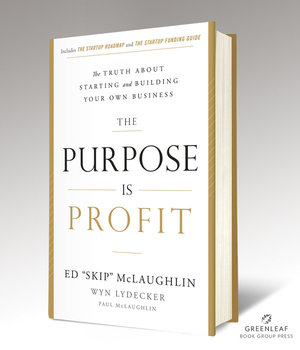
By Ed McLaughlin
The key economic factors impacting the value potential of any business include Capital, Cost & Control. Understanding the meaning and purpose behind each of these words will have a direct impact on vision fulfillment, value realization, and personal satisfaction. It is imperative to slow-down and take the time to understand the implications of each of these words. Sometimes entrepreneurs can get ahead of themselves in the pursuit of start-up capital and unnecessarily give-away too much.
It is important to remember that one of the many reasons that you decided to start your own business was to work for yourself. You want to have decision-making authority, you want to be responsible for the plan, you want to fulfill your vision, and you want to realize the value. Since start-up capital is the primary negotiating lever for control, you need to make absolutely sure that you need outside capital to realize your business vision. The cost of start-up capital from an equity investor is degree of control. Loss of control can be a permanent decision.
Start-up capital is the precious fuel that enables every business engine to start. While cash flow is the continuous feed of new fuel that keeps every business running. A smooth running business engine is creating more fuel than it is consuming resulting in the generation of profit. A highly efficient business engine can produce substantial and consistent profits. Sustainable profits drive equity value for the owners. Equity value is a marketable asset that can be sold for multiples of profit. It makes sense to think-thru these concepts long and hard before selling your equity.
When I started USI in 1991, I was convinced that I needed start-up capital. I was naïve but lucky. I had saved up a sizeable nest-egg but I was advised that OPM was the way to go. OPM is the acronym for Other People’s Money. On the surface, OPM seemed to make sense. I put together a shortlist of wealthy friends and family to consider as equity investors. The more I thought about it, the more I did not like the idea. I had strong feelings about risking their hard-earned savings. I was also concerned about getting friends & family involved in my business. I started to think more about bootstrapping or borrowing rather than selling equity. Lucky Decision #1.
So I stopped at my personal savings bank and inquired about a loan. I had good credit and had always fulfilled all of my obligations. Much to my surprise, I was greeted with a stop sign. Given the recent real estate lending crisis in 1990, my bank was not really interested in lending money to a new real estate services business. Even still, I was asked to fill-out a boatload of paperwork and to submit a business plan. Even though the bank held a good amount of my personal savings, they would only lend an amount equal to the value of my savings. Said another way, my personal savings bank wanted a fully-collateralized loan (dollar for dollar). My bank would not extend one-cent of risk for me. More and more, I started to think about bootstrapping my business without 3rd Party involvement – but I had one more base to cover. Lucky Decision #2.
I decided to pursue a Small Business Administration (SBA) loan. I felt certain an SBA Lender would provide me with a loan. When I met with the SBA Loan Officer, they were not excited about lending to a new real estate services business. However, they did agree to review my loan request but they needed three (3) boatloads of paperwork, a comprehensive business plan and a cash flow analysis indicating the breakeven and profitability point. The business plan, breakeven and profitability analysis seemed reasonable but the boatloads of paperwork seemed onerous. The deal-breaker for me was the need to hurry-up and wait. The SBA Lender said that it would take more than three (3) months to secure a directional decision – not a final decision. I could not wait that long to get going. Lucky Decision #3. NOTE: The SBA has come a long-way since I considered applying for my loan.
Why did I consider these outcomes lucky? – because I was forced to bootstrap the whole thing myself. I invested $100,000 of start-up equity in USI and we never looked back. We secured bankable pre-orders that produced positive cash flow and profit from the fourth month of operation.
We maintained 100% control of the business and learned how to run and build the business without ever borrowing any money. There were no outside owners, just owner-operators. We never had any debt – other than a flexible Line of Credit (LOC) for a rainy day. As we grew, we built a sizeable after-tax surplus that became a strategic weapon for growth.
This strategy of self-funded growth worked for USI throughout the life of the business. Self-funded growth is not necessarily the best-way to go for all early stage businesses. I do believe that self-funding is the best-way to go for all businesses during the start-up phase.
In summary, Capital is the fuel for the business engine. Cost is the throttle on the business engine that consumes the fuel. Control is the owner of the business engine that realizes value creation. I was lucky. You need to be smart. Think-thru the ramifications of selling equity at the expense of losing control.
Ed “Skip” McLaughlin is the author of The Purpose Is Profit: The Truth about Starting and Building Your Own Business, along with co-authors Wyn Lydecker and Paul McLaughlin. The Purpose Is Profit is available on Amazon.com and at your favorite bookstore now.
Ed McLaughlin is the founder of four businesses and is currently running Blue Sunsets LLC, a real estate and angel investment firm based in Darien, CT. Follow him at @purposeisprofit.

Order The Purpose Is Profit Here
Copyright © 2017 by Ed McLaughlin All rights reserved.




Leave A Comment